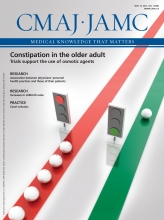Abstract
Background: Although much has been written about the potential power of the association between physicians’ personal health practices and those of their patients, objective studies of this relationship are lacking. We investigated this association using objectively measured health care indicators.
Methods: We assessed 8 indicators of quality of health care (screening and vaccination practices) for primary care physicians (n = 1488) and their adult patients (n = 1 886 791) in Israel’s largest health maintenance organization; the physicians were also patients in this health care system.
Results: For all 8 indicators, patients whose physicians were compliant with the preventive practices were more likely (p < 0.05) to also have undergone these preventive measures than patients with noncompliant physicians. We also found that more similar preventive practices showed somewhat stronger relations. For example, among patients whose physician had received the influenza vaccine, 49.1% of eligible patients received flu vaccines compared with 43.2% of patients whose physicians did not receive the vaccine (5.9% absolute difference, 13.7% relative difference). This is twice the relative difference (7.2%) shown for pneumococcal vaccine–eligible patients of influenza-vaccinated versus nonvaccinated physicians (60.9% v. 56.8%). When we examined the rates of unrelated practices, we found that, for example, mammography rates were identical for patients whose physicians did and did not receive the influenza vaccine.
Interpretation: We found a consistent, positive relation between physicians’ and patients’ preventive health practices. Objectively establishing this healthy doctor–healthy patient relation should encourage prevention-oriented health care systems to better support and evaluate the effects on patients of improving the physical health of medical students and physicians.











